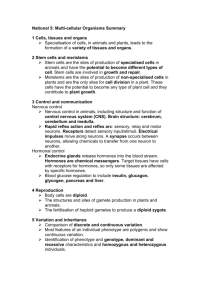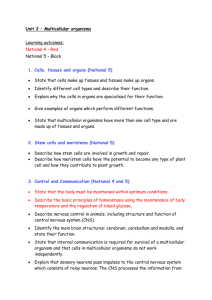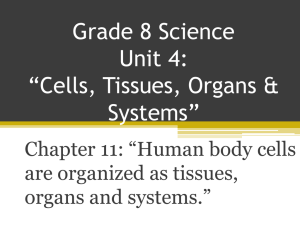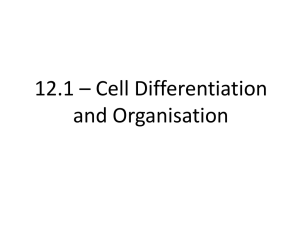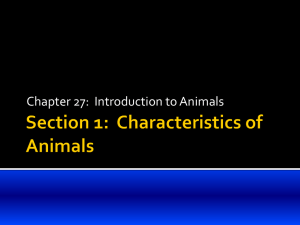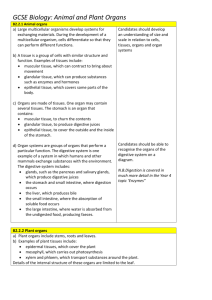Unit 2 Learning Outcomes
advertisement
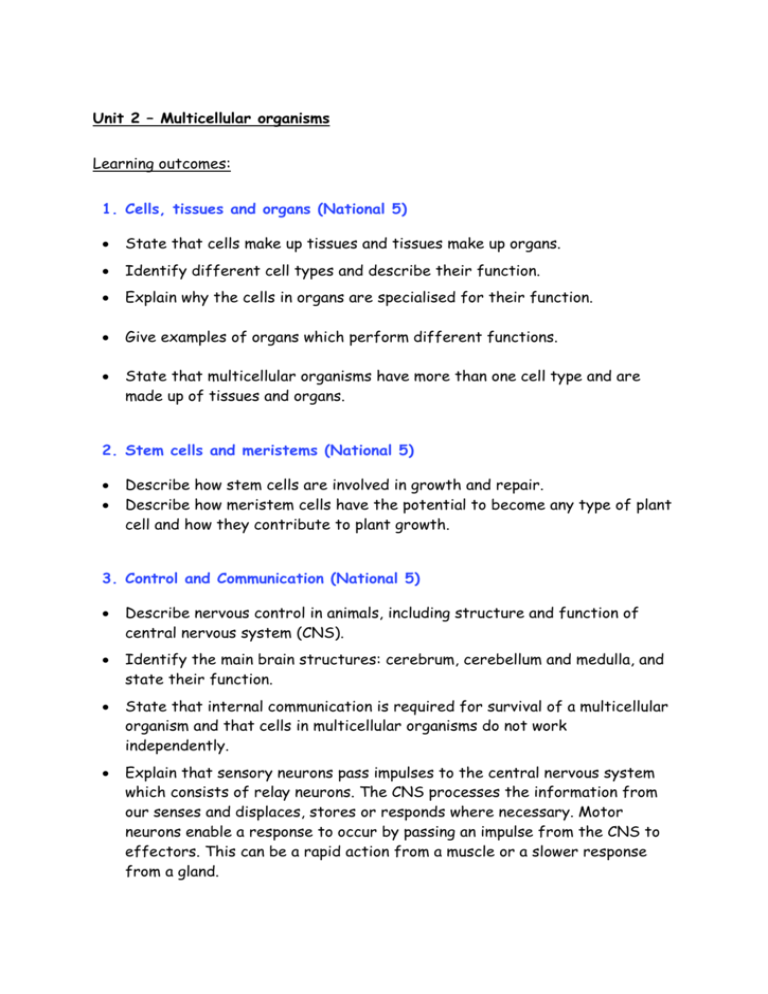
Unit 2 – Multicellular organisms Learning outcomes: 1. Cells, tissues and organs (National 5) State that cells make up tissues and tissues make up organs. Identify different cell types and describe their function. Explain why the cells in organs are specialised for their function. Give examples of organs which perform different functions. State that multicellular organisms have more than one cell type and are made up of tissues and organs. 2. Stem cells and meristems (National 5) Describe how stem cells are involved in growth and repair. Describe how meristem cells have the potential to become any type of plant cell and how they contribute to plant growth. 3. Control and Communication (National 5) Describe nervous control in animals, including structure and function of central nervous system (CNS). Identify the main brain structures: cerebrum, cerebellum and medulla, and state their function. State that internal communication is required for survival of a multicellular organism and that cells in multicellular organisms do not work independently. Explain that sensory neurons pass impulses to the central nervous system which consists of relay neurons. The CNS processes the information from our senses and displaces, stores or responds where necessary. Motor neurons enable a response to occur by passing an impulse from the CNS to effectors. This can be a rapid action from a muscle or a slower response from a gland. Describe the rapid reflex action and reflex arc using the words sensory, relay and motor neurons. The reflex arc uses receptors to detect sensory input/stimuli. Electrical impulses move along neurons. A synapse occurs between neurons, allowing chemicals to transfer from one neuron to another. Describe how endocrine glands release hormones into the blood stream. Explain that hormones are chemical messengers that target specific tissues. The target tissues have cells with receptors for specific hormones, so only some tissues are affected by specific hormones. Describe blood glucose regulation to include insulin, glucagon, glycogen, pancreas and liver. Explain using an example such as diabetes to show a communication pathway that has failed due to a fault in release or a failure to respond to insulin and consequences and treatment. Make a reference to the benefits of controlling blood glucose level in relation to osmosis in cells. 4. Sexual Reproduction (National 5) Explain the difference between the terms diploid and haploid. Describe the structures and sites of gamete production in plants and animals. Describe fertilisation in terms of haploid gametes fusing to produce a diploid zygote. 5. Variation and Inheritance (National 5) Explain that combining the genes from separate parents contributes to variation within a species. Describe the single gene inheritance of characters showing discrete variation where measurements fall into distinct groups. Compare discrete and continuous variation. Explain that carrier individuals of medical traits can receive genetic counselling. Identify the phenotype and genotype, dominant and recessive characteristics and homozygous and heterozygous individuals. Use family trees and pedigree charts to identify individuals. 6. Need for transport (National 5) State that water is required for transporting materials and for photosynthesis. Describe the structures and processes involved in water movement to include root hairs, guard cells, stomata, epidermis, mesophyll cells and transpiration. Explain that water and minerals are transported up through the stem in xylem and why xylem cells are lignified. Explain that sugar is transported up and down the plant in living phloem cells. State that in mammals, nutrients, oxygen and carbon dioxide are transported in the blood. Describe the pathway of blood through heart, lungs and body. Heart structure to include right and left atria and ventricles. Blood vessels to include: aorta, vena cava, pulmonary arteries and veins, and coronary arteries. Describe and explain the structures and functions of blood vessels. Arteries have thick, muscular walls, a narrow central channel and carry blood under high pressure. Veins carry blood under low pressure; have thinner walls and a wide channel. Veins contain valves to prevent backflow of blood. Capillaries form networks at organs and tissues, and are thin walled and have a large surface area, allowing exchange of materials. State that red blood cells contain haemoglobin and are specialised to carry oxygen. Describe the structures of the lungs. Rings of cartilage keep airways open. Oxygen and carbon dioxide are exchanged in the alveoli. Alveoli have a large surface area, a good blood supply and thin walls to allow diffusion of gases. Mucus traps dirt and microorganisms and cilia moves this up and out of the lungs. Describe transport through the mammalian digestive system. Food is moved through the digestive system by peristalsis. Villi in the small intestine are thin walled, have a large surface area and a good blood supply to aid absorption of glucose and amino acids. The lacteals transport the products of fat digestion. 7. Lifestyle and health (National 5) Describe how a lifestyle choice can affect the body. Lifestyle choices could include high-fat or high-salt diet, lack of exercise, use of tobacco or alcohol, or high-stress experiences. Possible effects on animal transport and exchange systems such as increasing the chances of fatty deposits in blood vessels, blood clots, heart attacks, strokes, diabetes and stress. Explain how certain environmental factors can impact on animal transport and exchange systems. Understand that heredity plays a part in the incidence of some conditions.
